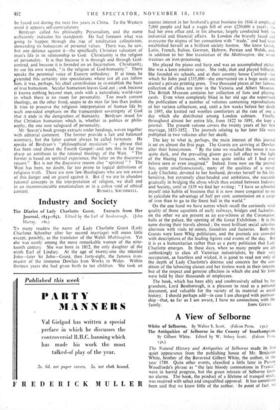Industry and Society
The Diaries of Lady Charlotte Guest. Extracts from Her
To many readers the name of Lady Charlotte Guest (Lady Charlotte Schreiber after her second marriage) will mean little except, possibly, as the translator of the Welsh Mabinogion. Yet she was surely among the more remarkable women of the nine- teenth century. She was born in 1812, the only daughter of the ninth Earl of Lindsey. At the age of twenty-one she Mitt-lied John—later Sir John—Guest, then forty-eight, the famous iron- master of the immense Dowlais Iron Works in Wales. Within thirteen years she had given birth to ten children. She took an intense interest in her husband's great business (in 1846 it employed 7,000 people and had a wages bill of over £250,000 a year) ; she had her own office and, in his absence, largely conducted both his industrial and financial affairs. In London she bravely faced and overcame the stigma of her connection with "trade," and had soon established herself as a brilliant, society hostess. She knew Greek, Latin, French, Italian, German, Hebrew, Persian and Welsh, and, in addition to her fine translation of the Mabinogion, she wrote treatises on iron-processing.
She played the piano and harp and was an accomplished etcher. She was a keen amateur actor. She rode, shot and played billiards. She founded six schools, and at their country house Canford—for which Sir John paid £335,000—she entertained on a huge scale and started a private printing press. Two thousand pieces of her famous collection of china are now in the Victoria and Albert Museum. The British Museum contains her collection of fans and playing- cards. Even when completely blind in her old age she supervised the publication of a number of volumes containing reproductions of her various collections, and, until a few weeks before her death in 1895, she knitted red woollen comforters at the rate of one a day which she distributed among London cabmen. Finally, throughout almost her entire life, from 1822 to 1891, she kept a journal. The present- volume covers the twenty years of her first marriage, 1833-1852.- The journals relating to her later life were published in two volumes after her death.
The key to what is, perhaps, the main interest of this journal is set on almost the first page. The Guests are arriving at Dowlais after their honeymoon. "By the time we reached the house it was quite dark, and the prevailing gloom gave full effect to the light of the blazing furnaces, which. was quite unlike all I had ever before seen or even imagined." indeed, from now on the journal has, quite unselfconsciously, many of the qualities of a novel. Lady Charlotte, devoted to her husband; devotes herself to his life. Sensitive, but extremely clear-headed and ambitious, she succeeds gradually in bridging the abyss which then existed between Industry and Society, until in 1839 we find her writing: "I have so schooled myself into habits of business that it is now more congenial to me to calculate the advantage of half per cent, commission on a cargo of iron than to go to the finest ball in the world?.
On the one hand we have scenes which recall the curiously vivid quality of those aquatints of early railways, bridges and factories ; on the other we are present as an eye-witness at the Coronation, balls at the palace, the opening of the Great Exhibition. .4, It is the same during their travels abroad ; the most brilliant social activities alternate with visits tar-mines, foundries and factories. Both the Guests were keen Whig politicians, and the journals are 'crowded with descriptions of the leading figures and events of the day. But it is as a humanitarian rather than as a party politician that Lady Charlotte emerges. In these days, when so many people are apt unthinkingly to class all Victorian industrialists, by their very occupation, as heartless and wicked, it is good to read not only of the depth of Lady Charlotte's distress and concern for the con- dition of the labouring classes and her tireless work in their interest, but of the respect and genuine affection in which she and Sir John were held by their thousands of employees.
The book, which has been ably and unobtrusively edited by her grandson, Lord Bessborough, is a pleasure to read as a personal document, and valuable for the variety of its material as social history. I should perhaps add—in case I am charged with partisan- ship—that, so far as I am aware, I have no connections with the


















































 Previous page
Previous page